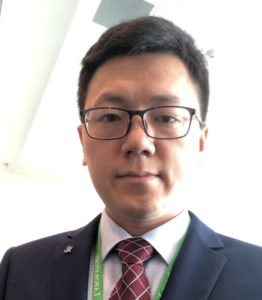 Congratulations to assistant professor Tianli Feng from the Department of Mechanical Engineering for receiving the 2023 Brillouin Medal, along with Professor Xiulin Ruan from Purdue University “for their formulation of four-phonon scattering theory and associated computational studies.”
Congratulations to assistant professor Tianli Feng from the Department of Mechanical Engineering for receiving the 2023 Brillouin Medal, along with Professor Xiulin Ruan from Purdue University “for their formulation of four-phonon scattering theory and associated computational studies.”
The Brillouin medal, awarded every two years by the International Phononics Society (IPS), honors a specific seminal contribution in the field of phononics (including phononic crystals, acoustic/elastic metamaterials, nanoscale phonon transport, wave propagation in periodic structures, coupled phenomena involving phonons, topological phononics, and related areas). Phonon is a quantized vibration of atoms in solids, responsible for many materials’ properties and functions.
Prof. Feng works on the interdisciplinary research areas of phonon physics and engineering. In the past, three-phonon scattering was the dominant phonon-phonon scattering mechanism. The higher-order four-phonon scattering was ignored due to the lack of general theory and perceived computational challenges. Ruan and Feng have been working on this problem since 2012, initially establishing a general theory of four-phonon scattering, and then extending the method to first principles. Their predictions explained the experimental temperature dependence of thermal conductivity in silicon. Later work also predicted that four-phonon scattering can significantly contribute to linewidth in infrared and Raman spectra for a wide range of materials.
“Four-phonon scattering is an intrinsic process in all crystals and determines the materials’ thermal transport ability and thermal radiative properties,” said Feng. “It is critical for discovering and designing materials for thermal barrier coatings, thermal management with ultra-high or ultra-low thermal conductivity, hypersonic vehicles, 2D functional devices, thermoelectrics, nuclear power plants, and radiative cooling.”
This research has led to the confirmation of high thermal conductivity and the four-phonon theory in boron arsenide, which has significant potential in electronics thermal management. The four-phonon scattering theory has gained wide acceptance across the fields of engineering, materials, physics, and chemistry. This has opened a new research area of higher-ordered phonon scattering and inspired numerous uses and further developments in a broad range of applications including high thermal conductivity materials, low thermal conductivity materials, high-temperature applications, two-dimensional materials, batteries, nuclear materials, thermoelectrics, infrared and Raman spectra, and thermal radiative transport. One highlight is that the theory has also assisted Ruan in creating BaSO4 radiative cooling paint, which earned a Guinness World Record title of the “World’s Whitest Paint.”
“It is a great honor for me to receive the Brillouin Medal for our work on four-phonon theory,” said Feng. “I am grateful to see that our research has been widely embraced by hundreds of researchers worldwide, who are using our theory and tools to advance their own research.”
Prof. Feng holds a B.S. degree in Physics from the University of Science and Technology of China (USTC) in 2011. He received his M.S. and Ph.D. degrees in Mechanical Engineering from Purdue University in 2013 and 2017, respectively, where he was awarded the Bilsland Dissertation Fellowship Honor. From 2017-2020, he worked as a Postdoc, and from 2020-2021, as an R&D Associate Staff Scientist at Oak Ridge National Laboratory. Prof. Feng’s research interests lie at the intersection of phonon physics and engineering, and he has participated/managed several interdisciplinary projects funded by NSF, DOE, and DOD. He has over 70 published papers, 3000+ citations, and an h-index of 33. He developed several open-source simulation packages, Windows-based applications, and online simulation tools. He has also been invited to give talks at several seminars and conferences and serves as an editorial board member of Energy and Environment Focus and an Early-Career Editorial board member of ES Energy & Environment, a journal of Engineered Science. He has also organized and chaired sessions at ASME and MRS conferences.
You can learn more about Professor Feng’s research through the Feng MEX Lab Website.